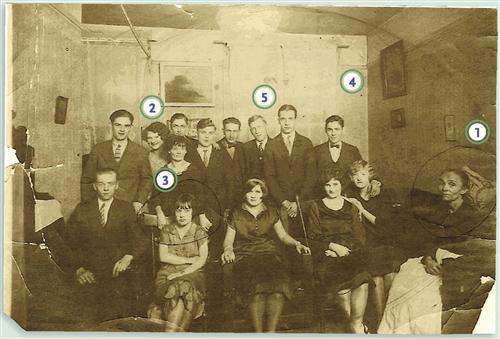Sign up for the Family Tree Newsletter Plus, you’ll receive our 10 Essential Genealogy Research Forms PDF as a special thank you!
Get Your Free Genealogy Forms
"*" indicates required fields
Even though the photo below is a question mark in Linda Hess’s family today, someone once knew who’s pictured and why they’re there. Perhaps that’s the person who circled two of the women. It wasn’t hard to come up with pretty solid IDs for those ladies, but who is everyone else, and why are they there? Let’s look at clues Hess can use to get the full story.
Doing the wave
Hess remembers her aunt telling her that this image is somehow connected to family from Missouri, and one of the women was supposed to be the mother of a relative named Grace Mink. The name serves as a starting place, but a general date would help Hess narrow her search. That’s the easy part of this photographic brick wall: Three women in the picture have permanent waves, with hair styled in what was called the “wavy shingle” during the early 1920s. The no-waist dresses confirm this.
Playing family detective
Now Hess has to figure out who’s depicted here by researching leads in oral traditions about Mink. Her family disputes Mink’s marriage to a man named William Curtis Nunnally, and their daughters’ deaths at a young age. Nunnally’s sister, Hess’ great-grandmother, always said her brother died an unmarried man, yet Hess’ aunt found proof of the marriage at St. Simon’s Church in Washington, Daviess County, Ind., Sept. 17, 1901. Federal census records fill in missing bits. In 1910, William (listed as Doug), Grace, their daughter Irene, and Grace’s mother, Honora (Nora, nee Smith), lived in Madison County, Ill. After William’s death in 1914, the 1920 census finds Grace Nunnally living with her mother and daughter in Missouri. She’s 36; Irene is 14. The household includes Grace’s mother, her brother Marion, his wife, their three children, and two lodgers. Irene — if that is in fact her circled in the front row — is a young teen, confirming the date of about 1920.
Making matches
The circled heads were someone’s attempt to point out a relationship. Hess and a distant relative believe Nora is the woman seated on the far right and Grace is standing behind the seated Irene. I tend to agree. Grace and Nora have same-shaped faces, mouths and noses; Irene probably favors her father. Their apparent ages here are right, too. But who are the rest of the young men and women in the picture? In 1920, Nora’s son would’ve been too old and her grandsons too young to be the men in this photo.
The key to solving their identities probably lies with extended family members’ photos. Several of the girls here resemble the Mink women, but let’s consider other possibilities. The others in this photo could be Nora’s own Smith kin; relatives of her husband, Andrew Mink; or family members of William Nunnally.
Shared facial traits may indicate a family group. For instance, the man standing second from the right resembles Irene — both have long faces. He could be her uncle or an older cousin. The younger man standing on the far left also looks like them, with strong eyebrows and facial features.
Meeting up
I’m not sure this picture was taken in a home. The high ceilings, pictures hanging high on the molding and strong overhead light are characteristic of institutional, rather than homey, decor. Even the furniture appears uncomfortable — wooden straight-back chairs and a bench on the right for Nora. Notice the pillow behind her head to make her comfortable.
Since the dresses’ predominant color is dark, two possibilities are likely: Grace and Nora are chaperoning an evening gathering of young people, or this is a family attending a wake. More research on collateral lines might turn up supporting evidence, such as an obituary or death announcement naming survivors. But the absence of older men and women other than Grace and Nora is unusual at a wake.
If this picture was taken in Missouri, finding Grace’s address in city directories or other documents could help identify the setting. With a street name, Hess could contact the local historical society to inquire about pictures of the neighborhood — home styles could indicate whether these folks posed in a house or business.
Since this is a 20th-century photo, many of these young people would’ve lived into the late 1900s. That makes it likely someone in Hess’ extended family will recognize them and name the occasion. It’s a matter of networking with distant cousins to figure out who’s who.

- Homing in. Use markings, family tales and research to pinpoint relatives.
- Cut ‘n curl. Look to hair as well as clothing for a photo date.
- Look-alikes. Facial similarities suggest relationships.
- Inside information. Study the background and compare it to other photos for location clues.
- Common traits. Characteristics everyone shares, such as age, sex and attire, could indicate an occasion.
From the July 2008 Family Tree Magazine
ADVERTISEMENT

